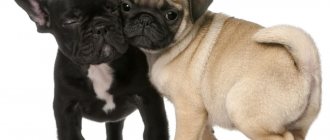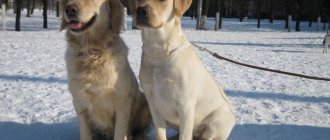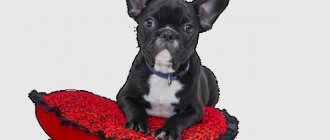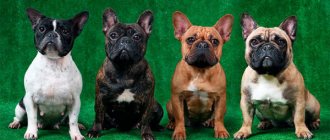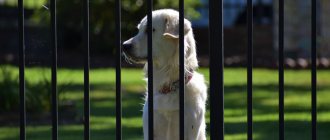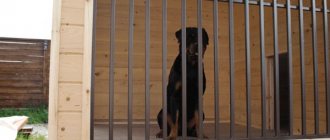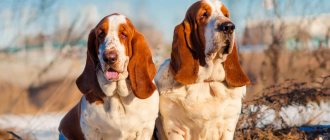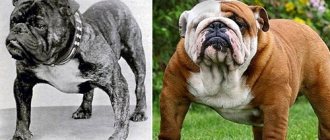Bulldogs are dogs that were bred in England and do not exceed medium size.
For example, the French bulldog is smaller in size than its counterparts.
This breed is quite popular because... Her most important quality is friendliness.
Dogs differ from each other in certain specific ways.
These dogs have characteristics of Molossian dogs.
However, they differ only in modest dimensions.
Origin of the breed
Translated from English, the name of the breed “bulldog” means “bull dog”. It is believed that bulldogs have a centuries-old history, going back to the Molossian dogs - mastiff-shaped fighting dogs. They belonged to the Greek noble family of Molossi in ancient Athens.
Molossian dogs were brought to England by Phoenician traders in the 6th century BC. It was they who became the ancestors of the first mastiffs, who, in turn, are considered the ancestors of modern bulldogs.
In Britain they were used in an unattractive and inhumane sport - bull baiting. The dog bit into the bull's nose and held it with its jaws until it fell. In 1835, a ban was imposed on this bloody sport, and a transformation took place in the education and use of the breed. The bulldog has ceased to be a formidable beast, turning into an ordinary pet.
Only the charisma of appearance and genetic memory remind of the former cruelty and stranglehold.
Today, there are several varieties of bulldogs, the most popular of which are English, American, and French. Despite the breed differences, there are characteristic features that allow dogs to be classified as a bulldog breed - a flattened (bull) muzzle with massive folds on it.
Famous owners
The French Bulldog is a fairly popular dog breed. The “fashion” for it began a couple of centuries ago and is still not slowing down.
Princess Tatiana Romanova, daughter of the Russian Tsar Nicholas II, had a “Frenchman” named Ortino. The dog was her favorite, but, unfortunately, the animal was executed along with all members of the royal family. Many years after the execution, the burial of a noble family was found, and among the remains they found the skeleton of a dog.
Another famous person who belonged to “blue” blood and doted on this breed was Prince Felix Yusupov. The famous artist Serov painted a portrait of the prince, which has survived to this day. It depicts Yusupov with his beloved French bulldog puppy on his lap.
Many representatives of the creative intelligentsia were also fond of bulldogs. For example, Fyodor Chaliapin kept several representatives of the breed. He never left them alone, he always took them with him on trips abroad. Many paintings have survived in which Chaliapin is depicted with his four-legged friends.
In 1920, the famous Soviet poet Vladimir Mayakovsky acquired a French bulldog in France, which he named Bulka. Just like Chaliapin, the poet never parted with his favorite.
French bulldogs are also popular among modern celebrities. Their owners are:
- The famous fashion designer Yves Saint Laurent started only this breed. Moreover, he called each dog the same as the previous one - Man.
- American actress Michelle Trachtenberg has a “Frenchie” named Mia;
- Christina Ricci is the owner of a dog named Ramon;
- Mick Jagger;
- Leonardo DiCaprio;
- Reese Witherspoon;
- Lady Gaga;
- Sergey Zhigunov;
- Laima Vaikule;
- Edita Piekha;
- Raisa Ryazanova.
French bulldogs have been and remain a very popular dog breed. It can be assumed that they will not lose their relevance even after many years.
English bulldog
English Bulldogs are the most popular variety. It is from them that the rest of the breeds originated. These dogs are considered a national treasure of Britain and have a distinct personality. It is no coincidence that they are credited with qualities characteristic of true gentlemen: phlegmaticity, equanimity, respectability, aristocracy and thoroughness.
The English Bulldog was bred to be a companion and bodyguard. But since in the process of development the breed lost its original functions, it became more vulnerable. That is why keeping animals requires great responsibility. Modern English Bulldogs look like this:
- The head is large. The circumference in the frontal projection is equal to the height of the animal.
- Eyes set low.
- The jaws are massive with an underbite. The muzzle is wide and short. The jaws were thick, drooping, covering the jaws on both sides.
- The ears are thin, small, and set wide apart. The shape of the ears is “rose”.
- The body is tightly articulated and short.
- The neck is thick, strong, the nape line is noticeably curved.
- The back is short, the stomach is retracted.
- The limbs are strong and muscular. The hind legs are somewhat lighter than the front ones.
- The tail is corkscrew-shaped or straight, low set, short.
Bulldogs have a short, smooth coat with no undercoat. Common colors: motley, solid, mute (solid with a black muzzle or mask).
English bulldog weight: male - 25 kg, female - 23 kg.
The character is calm, unperturbed, and lazy. Training is associated with certain difficulties due to stubbornness. The commands are understood well, but this does not mean that they are going to carry them out. In case of danger, rare courage and speed of reaction awaken in dogs.
Differences
The difference starts with classification. The FCI classifies them into different groups. The English bulldog for the second is “Pinchers, Schnauzers and Molossoids,” and the French for the ninth is “Companions and Toys.”
The differences in appearance are quite noticeable:
- Height: English at withers 35-40 cm, French – 30-35.
- Weight – 20-25 kg for the first and 8-15 kg for the second.
- Ears. English - located widely and high above the eyes, medium in size, thin, hanging on cartilaginous tissues. These ears are also called “rose petal”. French - arranged approximately the same as in English. The base of the ears is wide, they are rounded at the ends, and stand upright. This type is called "bat ears".
- Tail. Straight or corkscrew-shaped in English, and with kinks in French.
- Front legs. Visually curved in the first breed, this is due to wide forearms, straight in the second.
The French and English bulldogs have serious differences in character. The first active ones. They run with pleasure, have fun, travel in a bag and without it. The second ones are calm. Phlegmatic character, love of quiet walks, friendliness and at the same time a pronounced sense of self-esteem.
American Bulldog
Representatives of the American Bulldog breed are athletic, alert and temperamental dogs with a strong and strong compact body. They differ from the English ones in their extreme appearance: a large number of pronounced folds on the head, a lot of skin, and a straight topline.
The height of a male dog at the withers is 56-71 cm, weight is up to 31.5-54 kg. Bitches are smaller in size: up to 51-66 cm in height, and only 27-45 kg. Weight and height should be proportional to each other.
There are two types of American Bulldogs:
- standard (Scott type) - athletic, lean;
- classic (Jackson) - massive, large.
The characteristic features of the breed are:
- square head and muzzle;
- well developed straight limbs;
- tail set low, thick at the base and tapering to the tip;
- short back;
- lean body;
- overbite (for the classic type) or “reverse scissors” (for the standard).
When moving, the American Bulldog can develop rapid speed, change direction and jump with ease.
Representatives of this breed are distinguished by rare stubbornness, but thanks to their intelligence and intelligence, they are easily trained. They are prone to dominance, so they will obey only the person who can prove their leadership to the dog.
American Bulldogs are devoted to family. They are loyal to children, provided that they show respect towards them. Strangers are greeted with distrust, but without aggression. In case of danger, they are ready to selflessly protect the owner and other family members. From an early age, the puppy must be taught to adequately perceive strangers, explaining that not every stranger is an enemy.
Education and training
While training French Bulldogs, certain difficulties may arise. This is due to stubbornness, which is inherent in the dog’s character by nature. These dogs quickly get tired of repeating the same actions, so they begin to ignore the owner’s commands. In this case, it is very important to show calm, restraint and wisdom.
You cannot force a dog to follow commands by shouting or use physical violence against it. Such training methods are unacceptable. Otherwise, with such actions you will turn your four-legged friend into a frightened or aggressive animal. In this case, experienced trainers advise using treats for reward during the training process. And the classes themselves should be cyclical and short, but regular. This way you will achieve, although not quick, but sustainable results.
For particularly stubborn dogs, there are training methods that are based on the principle of play. If you cannot cope with the classes on your own, then it is better to contact a professional dog handler.
French Bulldogs have an excellent memory and they have the trait of being sentimental. Therefore, when you take a puppy into your home from a breeder, ask him for a toy or some thing that has always been near the dog. This will make it much easier for him to adapt to an unfamiliar place.
Education must begin from the first day of stay in a new home. Show strength of character right away, despite the puppy’s “tender” age. Don't give in to whining and piteous looks. From the very first days, you must show the dog which of you is the leader in the relationship. It will be almost impossible to retrain an adult dog.
Show the new family member where his seat, toilet, and food and water bowl are. In the first months, you can teach your baby such simple commands as “Sit!”, “Lie down!”, “Come to me!” It is with these basics that training should begin.
Until about a year old, the puppy will test your strength in every possible way and try to become a leader. Immediately stop this firmly, but without raising your voice. If the puppy obeys you, then do not forget to praise him for it. This will greatly speed up the learning process and strengthen your bond with the animal. For mischief, “reprimand” the dog in a stern and authoritative voice. But never use physical force.
Dog experts say that the character of a French bulldog is fully formed by sixteen weeks. Therefore, before this moment, you need to have time to establish contact with the animal, socialize it, teach it the first commands and necessary procedures.
French Bulldog
French bulldogs belong to the decorative breeds. These are medium-sized dogs, whose weight varies from 8 to 14 kg, height - up to 30 cm. Females and males are approximately the same. Weight and height are in proportion.
Distinctive features of the exterior: short muzzle, flat nose, forked lip, bulging eyes and erect ears, wide at the base and rounded at the top. There is a deep groove between the brow ridges, which, unlike other types of “bulldog” breed, does not continue on the forehead.
Colors: white, brindle, fawn. Cream is common in the USA, but is not recognized by European dog handlers. Black color is not allowed.
French bulldogs have a loyal, flexible, cheerful, and slightly capricious disposition. It is noteworthy that these babies are very brave and are ready to courageously fight for their owner.
What do they have in common?
They are equally stubborn and persistent. Both have a pronounced fearlessness, without hesitation for a second, they will rush to protect their owner if he is in danger.
Appearance
- Large heads, proportional to the body and similar in shape.
- Quite powerful jaws, they inherited them from their ancestors.
- Hanging fleshy lips. The upper ones are large, reaching down to the chin.
- Bite. Incorrect, due to protruding lower teeth.
- Nice folds in the head area.
Health, typical diseases
The main problem of all bulldogs, regardless of variety, is short airways (due to a compressed body and brachycephaly). Therefore, they snore loudly in their sleep, are extremely susceptible to colds, and are sensitive to overheating. According to statistics, one of the most common causes of death among bulldogs is heatstroke.
The hot season with high humidity is very dangerous for dogs: breathing is impaired and characteristic gurgling sounds appear. If you ignore these symptoms, the animal will develop laryngeal edema. This phenomenon is characterized by the accumulation of viscous mucus in the throat, which the dog is unable to cough up on its own. In the absence of timely help, the bulldog may die. The owner needs to know that a pet that has experienced heatstroke at least once in its life will subsequently always be at risk and suffer from overheating.
A dog that has suffered a heatstroke must be moved to a cool, dark place, given water, moistened the fur and cleared the airways of viscous secretions.
Bulldogs are prone to obesity, so their diet must be prepared with special care. Dogs need reasonable physical activity, since physical inactivity leads not only to excess weight, but also to rapid fatigue and shortness of breath.
Bulldog puppies, with rare exceptions, are born by caesarean section - as the only way to avoid all risks. This is due to the peculiarity of the structure of the pelvis of bitches: according to breed standards, it should be narrow, and puppies have too large a head. In addition, representatives of the breed are phlegmatic and lazy, and even childbirth cannot help bring muscle tone to the desired state.
Pathologies characteristic of bulldogs include:
- hip dysplasia;
- allergies;
- atopic and interdigital dermatitis;
- cataract;
- third eyelid adenoma (“cherry eye”);
- cysts between fingers;
In old age, bulldogs are diagnosed with femoral neck fractures, since the entire load is mainly placed not on the muscles, but on the joints.
As for life expectancy, bulldogs cannot be called long-livers. There are quite a lot of diseases to which they are susceptible, so not every person can support them.
Like all Molossians (Mastiffs, Boxers, Great Danes), they usually live 8-10 years. However, with good maintenance and healthy genetics, they can easily live up to 15 years.
conclusions
If it is difficult to choose between a Frenchman or an Englishman, you need to study how they differ from each other. For people who love active recreation and travel, the French bulldog is more suitable. This dog does not need additional physical activity, but walks every day are the key to health. An Englishman will be an excellent companion for calm, phlegmatic people. Calm, slow walks are ideal for this breed.
It is not advisable to have any of these dogs in a home with small children. Their ancestors are fighting breeds, and despite the muting of aggression at the genetic level, it manifests itself in certain situations.
Features of care
Grooming your short-haired bulldog needs to be done especially carefully and regularly. Using a damp disc or napkin (do not use soap), it is necessary to wipe the skin, paying special attention to the folds on the face and the area near the tail, so that moisture and dirt do not collect there - a favorable environment for the proliferation of microbes. Then wipe the skin dry with another clean napkin to avoid diaper rash and irritation. In hot weather, the procedure is carried out daily.
It is advisable to wipe the eyes and ears every day, and brush the teeth once a week.
Nutrition also deserves special attention. Almost all bulldogs suffer from allergies, so you need to buy special hypoallergenic food.
Bulldogs should not be kept in enclosures, because, firstly, they need close contact with their owners, and secondly, they are susceptible to colds. You need to walk with them, but not for very long, and for cold weather you will need warm clothes.
Who is better to choose?
Which one to choose is ultimately up to the buyer to decide. Here, first of all, you need to take into account your personal preferences. It is necessary to take into account the dog’s temperament and the availability of free time to exercise with it. Familiarize yourself with the rules of training and nutrition in more detail, study the diseases and other ailments characteristic of these breeds. In any case, you should not get these dogs if there are small children in the family. Still, their ancestors were fighting dogs and manifestations of aggression are possible at the genetic level.
How to buy a puppy
If you want to purchase a bulldog puppy, it is advisable to do this in a kennel. Here, the baby will be provided with the necessary documents and informed about subsequent vaccinations and feeding rules.
The primary selection criterion should be the health of the puppy. Choose the most active and inquisitive baby with strong, not too high or long legs and a moderate number of folds. The baby's coat should be neat and shiny, its eyes should be clean, and its mucous membranes should be pink.
